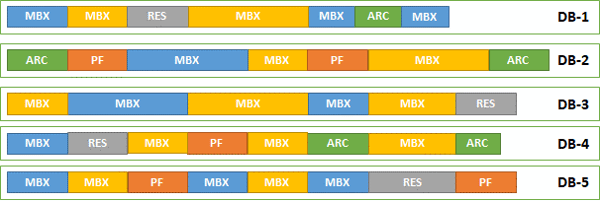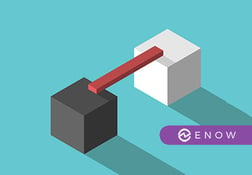March 2024 Security Update for Exchange 2019: Issues and April 2024 Hotfix Resolution
Introduction to the March 2024 Security Update
The March 2024 security update for Exchange 2019...


Since the early days of Exchange Server, the limits of user mailboxes were strictly regulated. In many Exchange organizations, these quota limits were configured on a mailbox database level and were therefore consistent for all mailboxes stored in the same database. This approach was selected because the existing hard disk space was scarce and expensive in the past.
The following example shows two databases (DB-USER-1 / -2) for standard users and one database with larger mailboxes for executives (DB-C level).

The approach to configuring quotas at a database level was never questioned when transitioning to modern versions of Exchange Server. The old operating patterns were merely taken over.
With modern Exchange Server versions and the Preferred Architecture recommendations this type of servicing of mailboxes no longer makes sense. One of the essential non-technical recommendations is to standardize and simplify the daily operation of the entire Exchange Server platform. Especially with a hybrid setup, which is the parallel operation of a local Exchange organization a and Exchange Online, it is recommended to simplify the service model.
You can standardize and simplify Exchange Server operations by configuring mailbox quotas at the mailbox level. This standardization eliminates the need for dedicated mailbox databases for different user groups. You can move mailboxes between any database, allowing you to respond to on-premises IT infrastructure challenges more flexible.
The following example illustrates this standardization with three mailbox databases (DB-1 / -2 / -3) which store a different number of mailboxes with varying quotas of mailbox.

The simplification becomes even more apparent when we look at the distribution of varying user mailboxes (MBX, blue/yellow) and activated online archive mailboxes (ARC, green).

In addition to user mailboxes and online archive mailboxes, there are other types of mailboxes:
For simplified and standardized operation, these additional mailbox types provide the following example with mailboxes distributed across five mailbox databases.

With a modern implementation of Exchange Server utilizing a Database Availability Group (DAG), you do not need a traditional backup solution. All required functions to protect mailboxes and mailbox content are integrated into the Exchange Server product. Therefore, it does not matter in which database a particular mailbox is stored. This type of operation is the same as the operating model in Exchange Online. In Exchange Online a user mailbox is stored in "a" mailbox database on “some” Exchange Servers.
Are there any disadvantages for such a simplified and standardized operation of mailbox databases in an on-premises Exchange organization?
There is one disadvantage to a standardized operation in an on-premises Exchange organization, at least if you continue to rely on traditional backup methodology and regularly restore mailbox content from a classic (or legacy) backup. In this case, you need to know in which database a mailbox was stored at the time of backup to restore exactly that single database explicitly. The Active Directory object of a mailbox owner has no history of the previous locations of a mailbox. The object stores the current mailbox database location only.
There are no restrictions regarding security for the service operation and administration of Exchange mailboxes. With Exchange Server Role Based Access Control (RBAC) you have all the options to allow management of dedicated mailboxes, e.g., executive mailboxes, to only specific support personnel. You should refrain from restricting the access to Active Directory objects by adjusting object permissions directly. Modifying the object security settings is much more insecure compared to controlling access using RBAC.
Modern operation of an Exchange organization with database-independent control of mailbox quotas provides flexibility and standardization. In a hybrid setup with Exchange Online, you operate mailboxes in the local Exchange organization in the same way as in Exchange Online. Therefore, you have a consistent mode of operation. The only differences are the different mailbox quotas compared to Exchange Online. Ideally, you also adjust the mailbox quotas in the on-premises Exchange organization to match those in Exchange Online.
If your on-premises IT infrastructure does not provide the necessary operational parameters for secure and stable operation of Exchange Server, but mailbox availability is essential to your business, then Exchange Online is the better alternative.
Enjoy Exchange Server.

Thomas Stensitzki is a Microsoft MVP, certified Exchange Server Master, and founder of Granikos GmbH & Co. KG, where he helps organizations modernize messaging, collaboration, and cloud security with Microsoft 365 and hybrid solutions. Alongside decades of deep technical expertise, Thomas has recently turned his focus to connecting technology with real-life conversations. He co-hosts the German-language podcast Cloudchroniken (https://cloudchroniken.de/), exploring the stories behind cloud technology, AI, and digital transformation. He also drives Discuss At Ease, an initiative inspired by his 2024 lymphoma diagnosis, creating open dialogue around illness, resilience, and well-being. A prolific speaker and trainer, Thomas shares insights at events like Experts Live and Exchange Summit. He contributes regularly to the Granikos blog, where his “Cumulative Update” series demystifies the latest in Exchange, Microsoft 365, Teams, and Copilot.

The March 2024 security update for Exchange 2019...


Exchange Online running on Microsoft’s Office 365 cloud platform operates more than 100,000 servers...